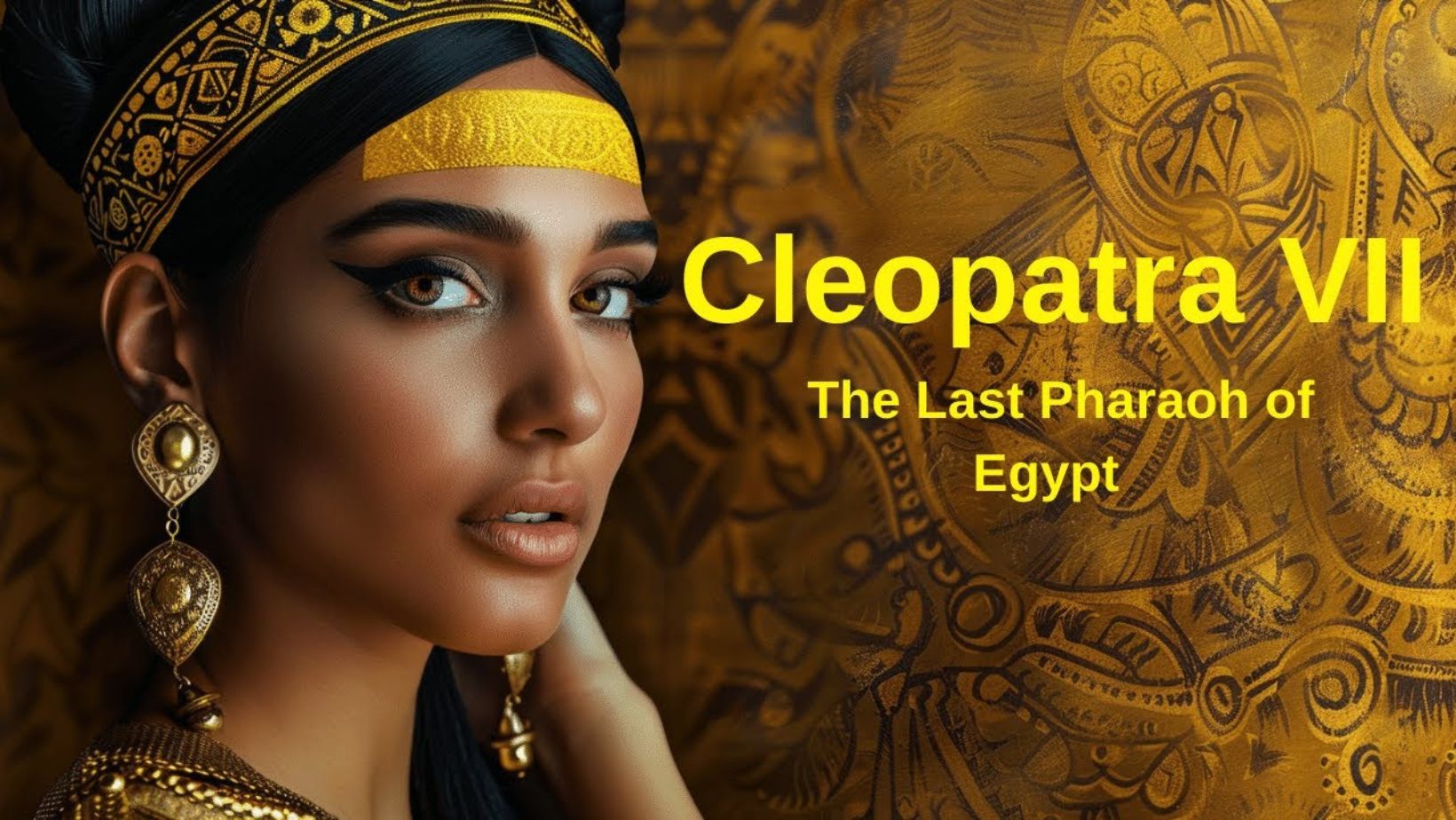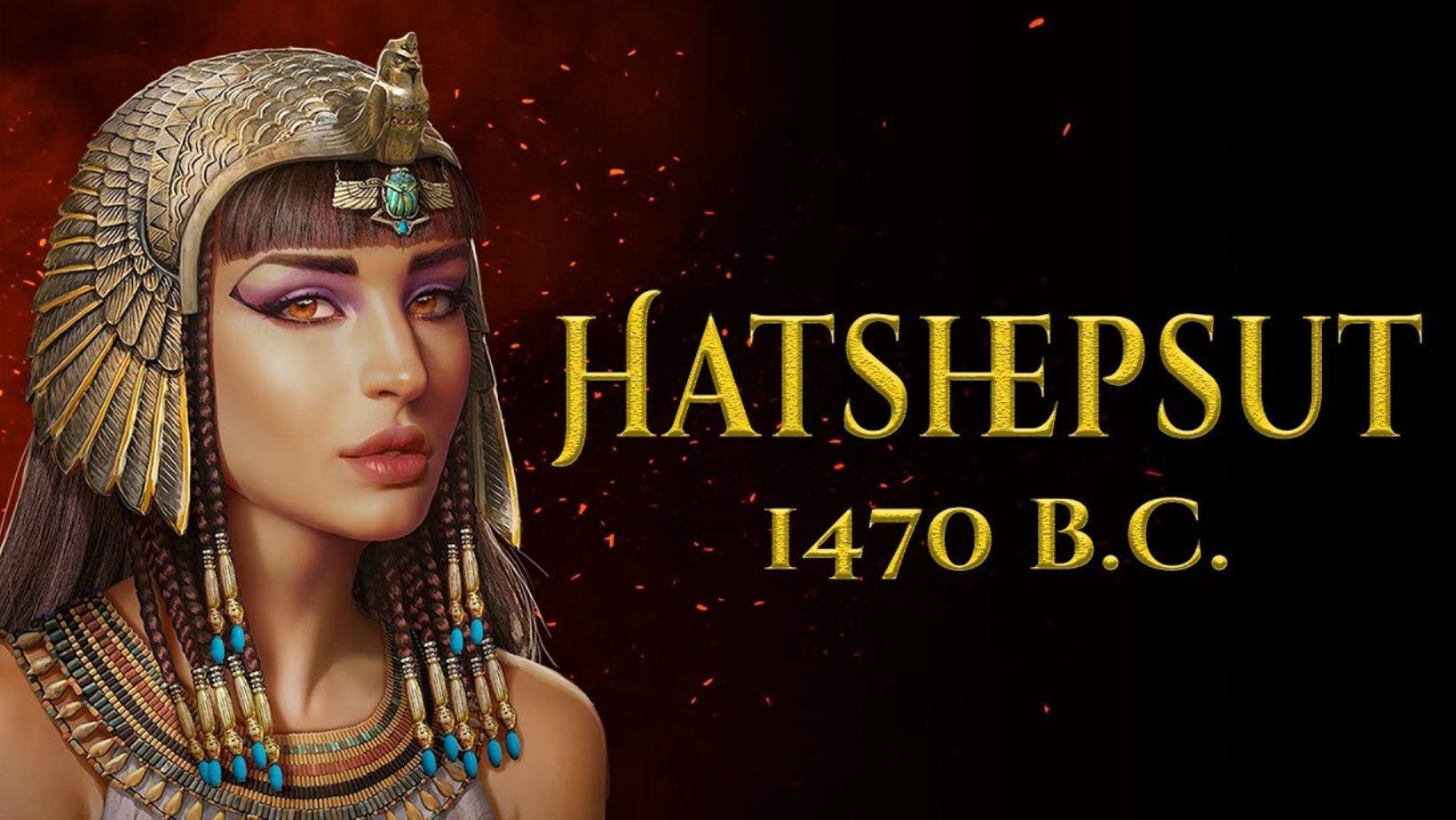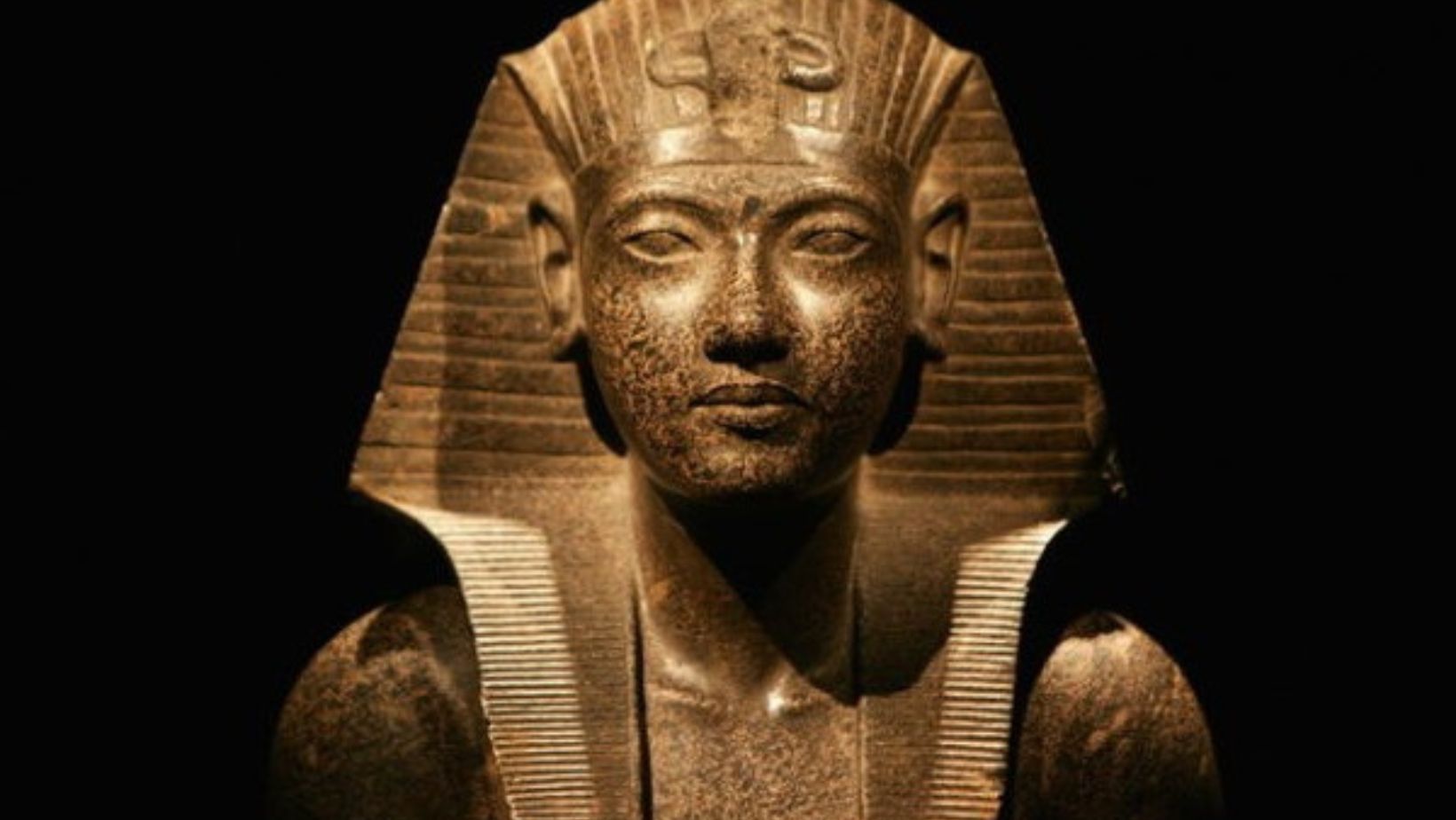Ancient Egypt is one of the most fascinating civilizations in history. It lasted for thousands of years, leaving behind stunning monuments, intricate art, and profound cultural influences. From majestic pyramids to groundbreaking advances in medicine, Egypt’s legacy is rich and varied. But what truly brings this ancient world to life are the remarkable figures who shaped its course. Leaders from Cleopatra to Tutankhamun, along with powerful queens and visionary architects, left indelible marks on their society. In this blog, we’ll explore these iconic figures and their enduring impact on history, culture, and the world we know today.
Cleopatra VII, The Last Pharaoh: Cleopatra to Tutankhamun

Cleopatra VII, the last pharaoh of Ancient Egypt, ruled from 51 to 30 BCE. Her reign was marked by political intrigue and efforts to restore Egypt’s power amidst Roman expansion. Cleopatra was highly educated, speaking multiple languages and understanding the complexities of diplomacy. She skillfully navigated the political landscape, aligning herself with powerful Roman leaders to secure her throne. Cleopatra to Tutankhamun
Her most famous relationships were with Julius Caesar and Mark Antony. Cleopatra first met Caesar in 48 BCE and formed a political and romantic alliance, which helped her regain her throne after being briefly ousted. Their union produced a son, Caesarion, whom Cleopatra hoped would inherit both Egyptian and Roman power.
After Caesar’s assassination in 44 BCE, she turned to Mark Antony, another key Roman figure. Their relationship was both romantic and political, aimed at forming an alliance against their mutual rival, Octavian. Cleopatra and Antony’s partnership ultimately led to their downfall, as they faced defeat at the Battle of Actium in 31 BCE. Cleopatra’s life and reign symbolize the last flicker of Egypt’s independence before it became a province of Rome.
Tutankhamun, The Boy King: Cleopatra to Tutankhamun
Tutankhamun, often referred to as the Boy King, ascended to the throne at a young age, around eight or nine years old. He ruled during the 18th dynasty of the New Kingdom, from approximately 1332 to 1323 BCE. His reign was significant, as it marked a return to traditional polytheistic beliefs after the monotheistic rule of Akhenaten, his likely predecessor. Tutankhamun’s short reign ended with his untimely death, likely around 18 years old.
The discovery of his nearly intact tomb in 1922 by British archaeologist Howard Carter was a watershed moment in Egyptology. Located in the Valley of the Kings, the tomb was filled with incredible treasures, including gold artifacts, a chariot, and the famous golden mask. The wealth and condition of the tomb offered invaluable insights into ancient Egyptian burial practices and daily life. This discovery sparked a global fascination with ancient Egypt and significantly advanced the field of Egyptology, leading to further archaeological exploration in the region. Tutankhamun’s legacy endures through his tomb’s artifacts, captivating the imaginations of people around the world.
Ramesses II, The Great Builder: Cleopatra to Tutankhamun
Ramesses II, also known as Ramesses the Great, ruled Egypt from 1279 to 1213 BCE. His reign lasted 66 years, making him one of the longest-serving pharaohs in history. Ramesses was a formidable military leader, known for his campaigns against the Hittites and Nubians. His most famous battle, the Battle of Kadesh, showcased his military prowess, even though it ended in a stalemate.
In addition to his military achievements, Ramesses II was a prolific builder. He undertook extensive construction projects that showcased Egypt’s wealth and power. Among his most notable contributions are the temples at Abu Simbel, carved directly into the mountainside, and the Ramesseum, his mortuary temple in Thebes. These structures featured grand statues and intricate reliefs that celebrated his accomplishments and the divine.
Ramesses’ architectural projects were not just for show; they served to legitimize his reign and assert his place in history. His monumental art often depicted him as a god-like figure, emphasizing his connection to the divine. Today, Ramesses II is remembered not only for his military conquests but also for leaving an indelible mark on ancient Egyptian architecture and art. Cleopatra to Tutankhamun
Hatshepsut, The Female Pharaoh: Cleopatra to Tutankhamun

Hatshepsut, one of ancient Egypt’s most renowned female pharaohs, ruled from 1479 to 1458 BCE. She initially served as regent for her stepson, Thutmose III, but soon declared herself pharaoh. Hatshepsut’s reign is marked by extensive trade expeditions, most notably her famous journey to the Land of Punt. This trade boosted Egypt’s economy, bringing back valuable resources such as gold, ebony, and exotic animals.
In addition to trade, Hatshepsut was a prolific builder. She commissioned numerous construction projects, including her magnificent mortuary temple at Deir el-Bahari. This temple features impressive colonnades and reliefs depicting her accomplishments, blending seamlessly into the surrounding cliffs. Hatshepsut’s architectural legacy demonstrates her commitment to both her own image and Egypt’s glory.
Her portrayal in art and monuments was unique for a female ruler. Hatshepsut often depicted herself in male attire, wearing a pharaoh’s kilt and headdress, to assert her authority. Many statues show her with a false beard, emphasizing her role as a pharaoh. This representation helped solidify her status in a male-dominated society and established her as a powerful and effective leader in ancient Egypt.
Akhenaten: The Heretic Pharaoh
Akhenaten, often referred to as the Heretic Pharaoh, ruled Egypt from 1353 to 1336 BCE. He is best known for radically altering the religious landscape by promoting the worship of Aten, the sun disc. This monotheistic shift marked a departure from traditional polytheism, leading to the establishment of Atenism as the state religion. Akhenaten’s reforms were controversial and met with resistance from the powerful priesthood of Amun.
In addition to his religious reforms, Akhenaten initiated a significant artistic revolution. He encouraged a new style of art that broke away from the conventional, idealized forms of previous pharaohs. Art during his reign depicted a more naturalistic approach, showcasing the royal family in intimate and realistic poses. This portrayal emphasized the personal and domestic aspects of Akhenaten’s life, including affectionate scenes with his wife, Nefertiti, and their children.
Akhenaten’s artistic innovations contrasted sharply with the rigid formalism of earlier Egyptian art. However, after his death, many of his reforms were reversed, and traditional beliefs and artistic styles were restored. Despite this backlash, Akhenaten’s reign remains a fascinating chapter in ancient Egyptian history, reflecting profound changes in religion and art. Cleopatra to Tutankhamun
Nefertiti: The Iconic Queen
Nefertiti, the iconic queen of Akhenaten, is renowned for her extraordinary beauty and influence. She ruled alongside her husband during a transformative period in ancient Egypt, known for promoting the worship of the sun god Aten. Nefertiti played a significant role in the religious and political changes of her time. Her image is often associated with elegance and power, exemplified by the famous bust discovered in 1912, which remains one of the most recognizable symbols of ancient Egypt.
Her legacy extends beyond her reign as queen. Nefertiti is frequently depicted in art, showcasing her alongside Akhenaten and their children in tender family scenes. These representations highlight her vital role in both the royal family and the religious transformation of the era. Cleopatra to Tutankhamun
In modern culture, Nefertiti has become an enduring symbol of female strength and beauty. She inspires countless works of art, literature, and film, showcasing her impact on popular culture. Nefertiti’s legacy as a powerful and influential figure continues to resonate today, making her one of the most celebrated queens in history. Her story reflects the complexities of gender and power in ancient Egypt.
Seti I: The Warrior King
Seti I, often referred to as the Warrior King, ruled Egypt from 1290 to 1279 BCE. He is celebrated for his military prowess and successful campaigns against foreign enemies, particularly the Hittites and Libyans. Seti I reasserted Egypt’s power in the region, securing its borders and expanding territory. His victories were documented in inscriptions and reliefs, showcasing his role as a formidable military leader.
In addition to his military achievements, Seti I made significant contributions to temple construction. He initiated extensive building projects, most notably the Temple of Seti I at Abydos. This temple featured elaborate reliefs and inscriptions that celebrated his reign and the gods he worshipped. Seti I’s architectural legacy also includes the construction of various temples at Karnak, showcasing his devotion to the deities and the state.
His artistic style, characterized by intricate carvings and vibrant colors, set a standard for subsequent pharaohs. Seti I’s reign marked a period of stability and artistic flourishing in ancient Egypt. His dual legacy as a warrior and builder left an indelible mark on Egyptian history. His contributions shaped the religious and political landscape for future generations. Cleopatra to Tutankhamun
Imhotep, The Polymath: Cleopatra to Tutankhamun
Imhotep was a remarkable figure in ancient Egypt, known for his wide-ranging contributions as an architect, physician, and writer. He is best remembered for designing the Step Pyramid of Djoser at Saqqara, one of the earliest large-scale stone structures in history. His innovative use of limestone and mastery of construction techniques set the foundation for future monumental architecture in Egypt. Imhotep’s architectural achievements laid the groundwork for the grandeur of later pyramids.
In addition to his architectural skills, Imhotep was revered as a physician. He is considered one of the earliest doctors in history, with texts attributed to him highlighting medical practices and treatments. His work emphasized the importance of observation and diagnosis, influencing medical practices in Egypt and beyond.
Imhotep’s contributions extended to literature, where he is credited with writing hymns and texts on wisdom. His legacy was so profound that he was later deified, becoming the god of wisdom and healing. Imhotep’s influence reached beyond ancient Egypt, inspiring later cultures, including the Greeks and Romans. His lasting impact on architecture, medicine, and literature highlights his status as a true polymath of ancient history.
Merneptah, The Pharaoh of the Sea Peoples: Cleopatra to Tutankhamun

Merneptah, the son of Ramesses II, ruled Egypt during the 13th century BCE. His reign was marked by significant military conflicts, particularly against the Sea Peoples, a confederation of naval raiders. These groups threatened the stability of Egypt and other Eastern Mediterranean regions. Merneptah’s military campaigns successfully defended Egypt, culminating in the famous Battle of the Delta.
The Merneptah Stele is one of the most significant artifacts from his reign. This stone monument details Merneptah’s victories and is notable for being the first historical reference to Israel. The inscription celebrates his military triumphs and emphasizes the power of Egypt during his rule. It serves as a vital primary source for understanding the geopolitical landscape of the time.
The stele’s significance extends beyond its inscriptions. It provides insights into the relationships between Egypt and neighboring regions. Moreover, it highlights the cultural and political climate of the Late Bronze Age. Merneptah’s reign and the Merneptah Stele collectively underscore the resilience of Egypt against external threats and contribute to our understanding of ancient history.
Conclusion: Cleopatra to Tutankhamun
The figures of Ancient Egypt, from Cleopatra to Tutankhamun, have profoundly shaped the course of history. Their political maneuvers, military achievements, and cultural contributions have left an indelible mark on Egyptian civilization. These leaders not only influenced their contemporaries but also continue to fascinate modern culture through literature, film, and art. Scholarship surrounding their lives enriches our understanding of ancient societies and their complexities. As we explore their legacies, we recognize how these iconic figures still resonate today, reminding us of the timeless human stories that connect past and present.
FAQs
What were the primary achievements of Cleopatra VII?
Cleopatra VII is renowned for her political acumen, particularly her alliances with powerful Roman leaders like Julius Caesar and Mark Antony. She worked to restore Egypt’s economy and culture during her reign. Additionally, she was a patron of the arts and sciences, promoting learning and knowledge throughout her kingdom.
Why is Tutankhamun’s tomb so significant?
Tutankhamun’s tomb, discovered in 1922 by Howard Carter, is one of the most important archaeological finds in history. The tomb contained a wealth of artifacts that provided insight into Ancient Egyptian burial practices and beliefs about the afterlife. Its discovery sparked a renewed interest in Egyptology and revealed the incredible craftsmanship of ancient artisans.
How did Hatshepsut challenge gender norms as a female pharaoh?
Hatshepsut broke traditional gender roles by assuming the title of pharaoh and portraying herself in male attire in statues and reliefs. She focused on trade and building projects, enhancing Egypt’s wealth and power. Her reign marked a significant era of peace and prosperity, defying expectations of female leadership in a patriarchal society.
What were Akhenaten’s contributions to religion?
Akhenaten is best known for his radical religious reforms, promoting the worship of Aten, the sun disk, as the sole deity. This shift from polytheism to monotheism marked a significant change in Egyptian religious practices. His reign also saw a unique artistic style that depicted the royal family in a more naturalistic manner, breaking from traditional representations.
How did Imhotep influence later cultures?
Imhotep was a polymath known for his contributions to architecture, medicine, and literature. He designed the Step Pyramid of Djoser, one of the first monumental stone buildings. His medical texts and practices laid foundations for future medical knowledge. Imhotep was later deified as a god of wisdom and healing, influencing various cultures in antiquity and beyond.

